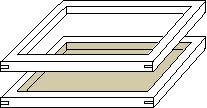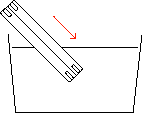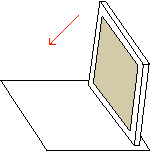
Rice Paper
Contact
Home

Making Your Own Rice Paper
By following instructions below you can make an attractive rice paper, fine or textured, from rice straw, bamboo, or mulberry. Homemade papers may not like fine papers on the market, but they bear the character of their maker.
Pulping. Rice Straw Bamboo MulberryEquipment
- A rust-proof pail
- A stainless steel pot
- A mortar and pestle or bat and board
- A large boiling pot
- A sharp knife
- Wood ash
- Rubber gloves
- Sieves
- Prepare rice straw by cutting them about 1 inch long and strip off the leaves. The nodes in stem aren't great for papermaking. Chop them off and use only the straight stiff segments of stems between nodes.
- Soak the straw in a pail of cold water for a week or longer. When the water turns yellowish brown with pigment leaching out of the stems, change the water a few times during the soaking. Rinse the soaked straw thoroughly.
- Caustic solution is made from wood ash which may from your fireplace. Using wood ash solution for papermaking is time consuming, but it help yield stronger paper due to its gentle action and tendency to rinse out easily. The measurement of wood ash solution is made of 26 ounces of wood ash and 15 quarts of water for one pound of dry rice straw fiber. Boil wood ash for about half an hour and let it settle. On following day sieve the mixture into a stainless steel pot. If some ash managed to get through the sieve, line the sieve with a sheet of paper towel and filter the solution again. The solution is highly caustic - time for rubber gloves.
- Cook soaked straw in a large boiling pot filled with the caustic solution. It takes about three hours to break up the fibers. The rice straw is ready when it crumbles when pinched. Do not overcook the fiber. If it tears apart too easily, your paper will be weak. Rinse the cooked straw in cool water.

- Pound the cooked rice straw with a bat. Use some force, but allow the weight of the bat to do most of the work. The initial beating loosens the fiber strands and spreads them out. When the fiber has spread out, fold the fiber on themselves and repeat the beating until the fibers crushed into pulp.

Bamboo Pulping
- You can use bamboo leaves, branches and culms for your paper. If a fine rice paper is desired, use culms. Shred the plant material as finely as possible. A food processor may be helpful.
- Put 1 kg of shredded bamboo in a boiling pot, and fill it with the caustic solution as discussed above. Cook the bamboo about five hours. Test the bamboo fiber by feeling it. It is ready when it feels slippery.
- Sieve cooked bamboo through a fine screen. A nylon stocking can be an substitute. Wrap the fiber and wash it in clean fresh water, squeezing the bulge in the wrapping under the running water until it is clean.
- Remove the fiber from the wrapping and beat it until it is pulpy.
- Harvest mulberry branches that about 1 inch in diameter and about 8 feet in length.
- Cut the branches into even length that fit into a big pot. Place a vegetable steamer in the bottom of the pot and fill with about 2 inches of water. Put branches in the pot vertically and cover tightly with a lid. Steam the branches for at least 30 minutes, or until the bark shrinks back and is easy to peel away from the woody core.

- Strip inner bark from the mulberry branches while they are still warm. Make a vertical slit at the bottom of the mulberry branch to get the entire inner and outer bark in your hand. Scrape outer bark off the inner bark. Scraping off the outer bark ensures that your rice paper will turn out pure and white.
- Wash the stripped inner bark and pick out any remaining specks of outer bark. Cook damp mulberry fiber in wood ash solution for about 4 hours. Stir it occasionally until it pulls apart easily.
- Rinse the cooked fiber twice by dunking it into a bucket of clean water. Squeeze out the excess water and hand beat the bark fiber into pulp. If the fiber seems dry during beating, add some clear water.
Equipment
- Deckle and mould
- Vat
- A rust-proof pail
- Felts.
- Pressing board
- Rolling pin

- Fill a vat halfway with water. The vat should at least seven inches deep and two inches larger than your deckle and mould. Add fiber pulp to the vat and give your pulp a good stir. While the pulp still moving, dip your mould-and-deckle, front edge first, into the pulp. Lift it out of the vat and give it a little shake. This will let fibers woven together for a stronger paper.


- Drain the water for about five minutes. Take off the deckle. Do this carefully. If water dropped onto newly formed sheet by accident, take your mould back to the vat.
- Smoothly but not too slowly roll the mould, paper side down, onto a wet felt, or a blotting paper, with a stack of newspaper underneath. This will drive away the air between the paper and felt. Gently remove the mould. Place a piece of wet felt or blotting paper over the newly-made paper and couch another sheet of paper over it. Repeat this process until you have as many sheets as you want.

- Press out the water from the paper stack with a rolling pin. Dry each sheet of paper together with felt.
| Rice Paper |
|
About History Fiber Production Make Your Own Sizing |
| Uses |
|
Calligraphy Mounting Painting Relief Printing Rubbing Western Art Kite Paper Cut Lantern Surfboard Window Covering |